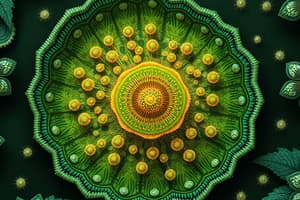Podcast
Questions and Answers
How would a plant's ability to effectively regulate its stomatal openings directly impact its photosynthetic efficiency, especially under conditions of high temperature and limited water availability?
How would a plant's ability to effectively regulate its stomatal openings directly impact its photosynthetic efficiency, especially under conditions of high temperature and limited water availability?
Effective stomatal control allows the plant to balance CO2 uptake for photosynthesis with water loss. Under heat and drought, optimized control prevents excessive water loss, maintaining turgor and allowing photosynthesis to continue, albeit potentially at a reduced rate.
Describe how the disruption of the cohesion-tension theory would affect a plant's ability to transport water from its roots to its leaves, and what visible symptoms might indicate this disruption?
Describe how the disruption of the cohesion-tension theory would affect a plant's ability to transport water from its roots to its leaves, and what visible symptoms might indicate this disruption?
Disruption of the cohesion-tension theory would severely impair water transport. Symptoms might include wilting, leaf curling, and ultimately, plant death due to dehydration.
Explain how the alteration of a plant cell's vacuole size or function could impact the plant's ability to respond to drought conditions.
Explain how the alteration of a plant cell's vacuole size or function could impact the plant's ability to respond to drought conditions.
Altering vacuole size or function could impair the plant's ability to store water and maintain turgor pressure, reducing its drought tolerance. Smaller vacuoles mean less water storage.
A plant is grown in a soil with a consistently high pH. Predict which essential micronutrient is likely to be least available for uptake, and describe the symptoms the plant might exhibit as a result of this deficiency.
A plant is grown in a soil with a consistently high pH. Predict which essential micronutrient is likely to be least available for uptake, and describe the symptoms the plant might exhibit as a result of this deficiency.
How would the inhibition of RuBisCO affect both the short-term and long-term survival of a plant? Consider the implications for carbon fixation and overall metabolism.
How would the inhibition of RuBisCO affect both the short-term and long-term survival of a plant? Consider the implications for carbon fixation and overall metabolism.
A plant is exposed to a toxin that inhibits the function of the electron transport chain (ETC) in the mitochondria. Describe the immediate effects on ATP production and the potential long-term consequences for the plant's survival.
A plant is exposed to a toxin that inhibits the function of the electron transport chain (ETC) in the mitochondria. Describe the immediate effects on ATP production and the potential long-term consequences for the plant's survival.
Explain how increased levels of abscisic acid (ABA) in a plant would influence its response to drought stress, including specific physiological changes that ABA would induce.
Explain how increased levels of abscisic acid (ABA) in a plant would influence its response to drought stress, including specific physiological changes that ABA would induce.
Describe the consequences if a plant's phytochromes were non-functional. How would this affect its ability to respond to changes in day length, and what aspects of its life cycle would be most impacted?
Describe the consequences if a plant's phytochromes were non-functional. How would this affect its ability to respond to changes in day length, and what aspects of its life cycle would be most impacted?
How would a mutation affecting the plant's ability to produce or respond to ethylene impact fruit ripening and abscission?
How would a mutation affecting the plant's ability to produce or respond to ethylene impact fruit ripening and abscission?
Explain the significance of mycorrhizae in plant nutrient uptake, specifically addressing how these symbiotic relationships enhance the acquisition of phosphorus from the soil.
Explain the significance of mycorrhizae in plant nutrient uptake, specifically addressing how these symbiotic relationships enhance the acquisition of phosphorus from the soil.
Flashcards
Botany
Botany
The scientific study of plants, covering their physiology, structure, genetics, ecology, distribution, classification, and economic importance.
Plant Cells
Plant Cells
Eukaryotic cells with membrane-bound organelles and a rigid cell wall made of cellulose.
Chloroplasts
Chloroplasts
Organelles responsible for photosynthesis, containing chlorophyll.
Vacuoles
Vacuoles
Signup and view all the flashcards
Water Potential
Water Potential
Signup and view all the flashcards
Transpiration
Transpiration
Signup and view all the flashcards
Plant Macronutrients
Plant Macronutrients
Signup and view all the flashcards
Photosynthesis
Photosynthesis
Signup and view all the flashcards
RuBisCO
RuBisCO
Signup and view all the flashcards
Plant Hormones
Plant Hormones
Signup and view all the flashcards
Study Notes
- Botany is the scientific study of plants, covering their physiology, structure, genetics, ecology, distribution, classification, and economic importance
- Plant physiology studies plant functions and processes
Plant Cell Structure
- Plant cells are eukaryotic, containing membrane-bound organelles like the nucleus, mitochondria, and plastids
- A key feature of plant cells is the presence of a rigid cell wall, primarily composed of cellulose, providing support and structure
- Chloroplasts are organelles responsible for photosynthesis, containing chlorophyll that captures light energy
- Vacuoles in plant cells are large, fluid-filled sacs that maintain cell turgor pressure, store nutrients, and degrade waste
- The endoplasmic reticulum (ER) is involved in protein and lipid synthesis
- The Golgi apparatus processes and packages proteins
- Ribosomes are responsible for protein synthesis
- The cytoskeleton, made of microtubules and microfilaments, provides structural support and facilitates intracellular transport
Plant Water Relations
- Water is vital for plant life, serving as a solvent, reactant, and transport medium
- Water potential describes the potential energy of water per unit volume relative to pure water at atmospheric pressure and temperature
- Water moves from areas of high water potential to areas of low water potential
- Water potential is affected by solute concentration (osmotic potential), pressure (pressure potential), and gravity (gravitational potential)
- Osmosis is the movement of water across a semipermeable membrane from a region of high water potential to low water potential
- Transpiration is the process by which water evaporates from plant leaves, driving water movement up the plant
- The cohesion-tension theory explains water movement in plants, where transpiration creates tension, pulling water up the xylem due to cohesion and adhesion properties of water
- Stomata are pores on leaves that regulate gas exchange and transpiration, opening and closing in response to environmental cues
- Guard cells control the opening and closing of stomata, influenced by light, carbon dioxide concentration, and water availability
- Water uptake occurs through root hairs, increasing the surface area for absorption
- Water moves through the root cortex via apoplastic (cell wall) and symplastic (cytoplasmic) pathways to reach the xylem
Mineral Nutrition
- Plants require essential mineral nutrients for growth and development, obtained from the soil
- Macronutrients are needed in larger quantities: nitrogen (N), phosphorus (P), potassium (K), calcium (Ca), magnesium (Mg), and sulfur (S)
- Micronutrients are needed in smaller quantities: iron (Fe), manganese (Mn), zinc (Zn), copper (Cu), boron (B), molybdenum (Mo), and chlorine (Cl)
- Nitrogen is a component of amino acids, proteins, and nucleic acids, essential for plant growth and metabolism
- Phosphorus is a component of nucleic acids, ATP, and phospholipids, important for energy transfer and membrane structure
- Potassium regulates osmotic potential, enzyme activation, and stomatal movement
- Nutrient deficiencies can cause specific symptoms, such as chlorosis (yellowing of leaves) due to nitrogen or iron deficiency
- Soil pH affects nutrient availability: acidic soils can increase the solubility of certain minerals (e.g., aluminum), while alkaline soils can reduce the availability of others (e.g., iron)
- Mycorrhizae are symbiotic associations between fungi and plant roots, enhancing nutrient and water uptake
- Nitrogen fixation is the conversion of atmospheric nitrogen gas into ammonia by bacteria, making it available to plants
Photosynthesis
- Photosynthesis is the process by which plants convert light energy into chemical energy, producing glucose and oxygen
- The process occurs in chloroplasts, specifically in the thylakoid membranes and stroma
- The overall equation for photosynthesis is: 6CO2 + 6H2O + Light Energy → C6H12O6 + 6O2
- The light-dependent reactions occur in the thylakoid membranes, where light energy is absorbed by chlorophyll and other pigments
- Photosystems I and II (PSI and PSII) are protein complexes involved in light absorption and electron transfer
- Water is split during the light-dependent reactions, releasing oxygen, protons, and electrons
- ATP and NADPH are produced during the light-dependent reactions, providing energy and reducing power for the Calvin cycle
- The Calvin cycle (light-independent reactions) occurs in the stroma, where carbon dioxide is fixed and converted into glucose
- Ribulose-1,5-bisphosphate carboxylase/oxygenase (RuBisCO) is the enzyme that catalyzes the initial carbon fixation step
- The Calvin cycle involves three phases: carbon fixation, reduction, and regeneration of RuBP
- C4 photosynthesis is an adaptation to hot, dry environments, where carbon dioxide is initially fixed in mesophyll cells using PEP carboxylase, forming a 4-carbon compound (oxaloacetate)
- The 4-carbon compound is transported to bundle sheath cells, where it is decarboxylated, releasing carbon dioxide for the Calvin cycle
- CAM (Crassulacean Acid Metabolism) photosynthesis is another adaptation to arid conditions, where plants open their stomata at night to fix carbon dioxide, storing it as organic acids, and then use it during the day for photosynthesis
Respiration
- Respiration is the process by which plants break down glucose to release energy (ATP)
- Glycolysis occurs in the cytoplasm, breaking down glucose into pyruvate, producing a small amount of ATP and NADH
- The citric acid cycle (Krebs cycle) occurs in the mitochondria, oxidizing pyruvate to release carbon dioxide, ATP, NADH, and FADH2
- The electron transport chain (ETC) is located in the inner mitochondrial membrane, where electrons from NADH and FADH2 are passed through a series of protein complexes, generating a proton gradient
- Oxidative phosphorylation uses the proton gradient to produce ATP through ATP synthase
- Anaerobic respiration occurs in the absence of oxygen, resulting in fermentation, producing less ATP and by-products like ethanol or lactic acid
Plant Hormones
- Plant hormones (phytohormones) are chemical signals that regulate plant growth, development, and responses to the environment
- Auxins promote cell elongation, apical dominance, and root formation
- Cytokinins promote cell division, delay senescence, and stimulate shoot development
- Gibberellins promote stem elongation, seed germination, and flowering
- Abscisic acid (ABA) promotes dormancy, closes stomata during water stress, and inhibits growth
- Ethylene promotes fruit ripening, senescence, and abscission
- Brassinosteroids promote cell elongation and division, vascular development, and stress tolerance
- Jasmonates regulate responses to wounding and pathogen attack, as well as development
- Salicylic acid regulates plant defense responses against pathogens
- Plant hormones often interact with each other, influencing plant development and responses
Plant Development
- Seed germination is the process by which a seed emerges from dormancy and begins to grow, influenced by water, temperature, and oxygen
- Seedling development involves the growth of the root and shoot systems, establishing the plant's basic structure
- Vegetative growth includes the development of stems, leaves, and roots, driven by cell division and differentiation
- Flowering is the process by which plants transition from vegetative growth to reproductive growth, triggered by environmental cues such as day length and temperature
- Photoperiodism is the response of plants to the relative lengths of day and night, influencing flowering time
- Long-day plants flower when the day length exceeds a critical threshold, while short-day plants flower when the day length is below a critical threshold
- Phytochromes are photoreceptors that detect red and far-red light, regulating photoperiodism and other light-dependent processes
- Vernalization is the requirement of a period of cold temperature to induce flowering in some plants
- Fruit development follows pollination and fertilization, involving the growth and maturation of the ovary
- Senescence is the process of aging and eventual death of plant tissues or the entire plant, often involving the breakdown of chlorophyll and other cellular components
Studying That Suits You
Use AI to generate personalized quizzes and flashcards to suit your learning preferences.




